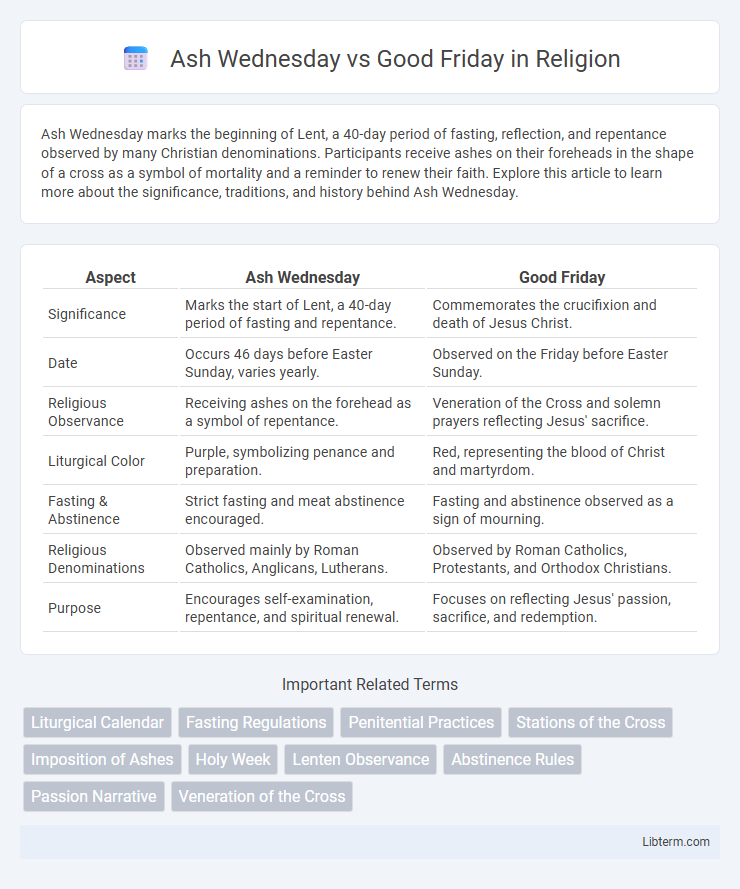Ash Wednesday marks the beginning of Lent, a 40-day period of fasting, reflection, and repentance observed by many Christian denominations. Participants receive ashes on their foreheads in the shape of a cross as a symbol of mortality and a reminder to renew their faith. Explore this article to learn more about the significance, traditions, and history behind Ash Wednesday.
Table of Comparison
| Aspect | Ash Wednesday | Good Friday |
|---|---|---|
| Significance | Marks the start of Lent, a 40-day period of fasting and repentance. | Commemorates the crucifixion and death of Jesus Christ. |
| Date | Occurs 46 days before Easter Sunday, varies yearly. | Observed on the Friday before Easter Sunday. |
| Religious Observance | Receiving ashes on the forehead as a symbol of repentance. | Veneration of the Cross and solemn prayers reflecting Jesus' sacrifice. |
| Liturgical Color | Purple, symbolizing penance and preparation. | Red, representing the blood of Christ and martyrdom. |
| Fasting & Abstinence | Strict fasting and meat abstinence encouraged. | Fasting and abstinence observed as a sign of mourning. |
| Religious Denominations | Observed mainly by Roman Catholics, Anglicans, Lutherans. | Observed by Roman Catholics, Protestants, and Orthodox Christians. |
| Purpose | Encourages self-examination, repentance, and spiritual renewal. | Focuses on reflecting Jesus' passion, sacrifice, and redemption. |
Introduction to Ash Wednesday and Good Friday
Ash Wednesday marks the beginning of Lent, a 40-day period of fasting, prayer, and repentance in the Christian liturgical calendar, symbolizing Jesus Christ's 40 days of fasting in the desert. Good Friday commemorates the crucifixion of Jesus and his death at Calvary, observed as a day of mourning and reflection on the sacrifice made for humanity's redemption. Both days hold profound spiritual significance in Christianity, emphasizing themes of repentance and salvation.
Historical Origins of Ash Wednesday and Good Friday
Ash Wednesday originated from early Christian penitential practices symbolizing repentance through the imposition of ashes, tracing back to the 8th century as a formal start of Lent. Good Friday commemorates the crucifixion of Jesus Christ and historically stems from the Gospel narratives, observed since at least the 4th century following the Council of Nicaea. Both days hold distinct liturgical significance, with Ash Wednesday marking preparation for Easter and Good Friday focusing on the Passion and sacrifice of Christ.
Liturgical Significance: Ash Wednesday vs Good Friday
Ash Wednesday marks the beginning of Lent, emphasizing penance, repentance, and the acknowledgment of human mortality through the imposition of ashes. Good Friday commemorates the crucifixion of Jesus Christ, highlighting themes of sacrifice, redemption, and the profound sorrow within the Passion narrative. Both days hold significant liturgical roles in preparing believers spiritually, with Ash Wednesday initiating the Lenten journey and Good Friday representing its solemn culmination.
Key Rituals and Traditions
Ash Wednesday marks the beginning of Lent with the key ritual of applying ashes in the shape of a cross on the forehead, symbolizing repentance and mortality. Good Friday commemorates the crucifixion of Jesus Christ through solemn church services, veneration of the cross, and often fasting or abstinence from meat. Both days emphasize reflection and penitence but differ in liturgical focus and associated customs.
Symbolism of Ashes and the Cross
Ash Wednesday symbolizes repentance and mortality through the imposition of ashes in the shape of a cross, reminding believers of human frailty and the need for spiritual renewal. Good Friday commemorates the crucifixion of Jesus Christ, with the cross representing sacrifice, redemption, and salvation in Christian theology. Together, these symbols emphasize the journey from repentance to redemption in the Lenten season.
Biblical Foundations of Both Observances
Ash Wednesday marks the beginning of Lent, symbolizing repentance and humility through the biblical practice of wearing ashes, as referenced in Genesis 3:19 and Jonah 3:6-10. Good Friday commemorates the crucifixion of Jesus Christ, grounding its observance in the New Testament accounts of His sacrifice in John 19 and Isaiah 53's prophecy of the Suffering Servant. Both days emphasize themes of penitence and redemption central to Christian theology, reflecting key scriptural narratives that shape worship practices.
Fasting and Abstinence Practices
Ash Wednesday marks the beginning of Lent and requires Christians to observe fasting by consuming only one full meal and two smaller meals that do not equal a full meal, along with abstinence from meat for those age 14 and older. Good Friday, commemorating the crucifixion of Jesus Christ, also mandates fasting and meat abstinence, with many believers practicing more rigorous fasting or even complete food abstention throughout the day. Both days are significant for penitential practices, emphasizing self-discipline and spiritual reflection through specific fasting and abstinence rules within Christian liturgical traditions.
Differences in Worship Services
Ash Wednesday worship services emphasize penitence and reflection with the imposition of ashes on the forehead, symbolizing human mortality and repentance. Good Friday services focus on commemorating the crucifixion of Jesus Christ through solemn prayers, scripture readings, and veneration of the cross, often including fasting and silence. The distinct liturgical elements highlight Ash Wednesday as the start of Lent and Good Friday as a somber remembrance of Christ's passion.
Theological Meanings and Reflections
Ash Wednesday marks the beginning of Lent, emphasizing repentance, mortality, and spiritual renewal through the imposition of ashes as a symbol of human sinfulness. Good Friday commemorates the crucifixion of Jesus Christ, highlighting themes of sacrifice, atonement, and redemption central to Christian theology. Both observances invite believers to reflect deeply on Christ's passion, the human condition, and the call to transformative faith.
Ash Wednesday and Good Friday in Modern Christianity
Ash Wednesday marks the beginning of Lent in modern Christianity, symbolizing repentance and spiritual reflection through the imposition of ashes on the forehead. Good Friday commemorates the crucifixion of Jesus Christ, emphasizing sacrifice and redemption as central themes in Christian faith. Both observances remain vital in contemporary liturgical practices, fostering deep theological contemplation and communal worship.
Ash Wednesday Infographic

 libterm.com
libterm.com